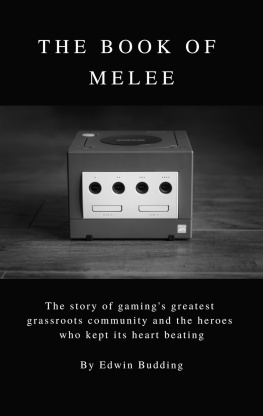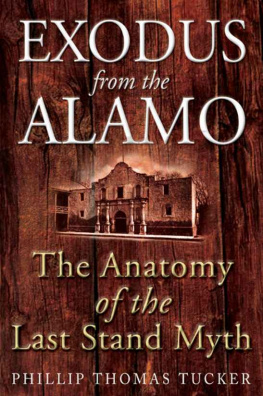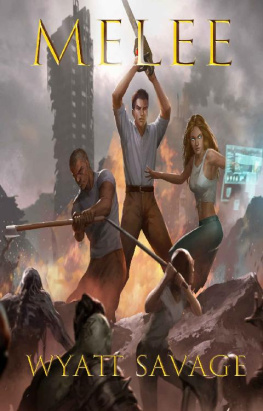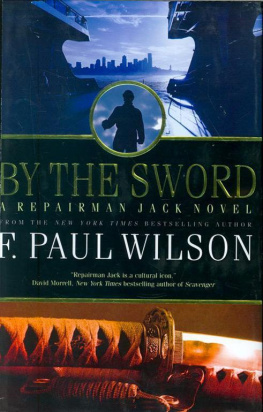The Book of Melee
By Edwin Budding
Smashwords Edition
Copyright 2019 by Edwin Budding
Researched and written by Edwin Budding
All rights reserved. Without limiting the rights under the copyright reserved above, no part of this publication may be reproduced, stored in, or introduced into a retrieval system, or transmitted in any form or by any means (electronic, mechanical, photocopying, recording, or otherwise) without prior written permission.
For permission requests, please contact the author.
Smashwords Edition License Notes
Thank you for downloading this ebook. This ebook is licensed for your personal enjoyment only. This ebook may not be re-sold or given away to other people. If you would like to share this book with another person, please purchase an additional copy for each recipient. If youre reading this book and did not purchase it, or it was not purchased for your use only, then please return to Smashwords.com and purchase your own copy. Thank you for respecting the hard work of this author.
Table of Contents
Its February 3, 2019. Oaklands Paramount Theater is set for the final day of Genesis 6, the newest edition of an annual three-day convention and tournament series dedicated to Nintendos Super Smash Bros. crossover fighting-game franchise.
The date: Championship Sunday, but not for the reasons one might expect. Instead of watching the Super Bowl, more than three thousand die-hard fans have packed themselves into the theater, now watching two grown men battling on stage for thousands of dollars and the title of world champion at their unlikely game of choice: Super Smash Bros. Melee, the second iteration of the Smash series.
One of the two competitors is Juan Hungrybox Debiedma, a twenty-five-year-old former chemical engineer and the reigning world no. 1. His unwavering resolve and dominance with his character, Jigglypuff, from the Pokmon franchise, has made him a community villain in the eyes of several peers, who resented his success and barely tolerated his penchant for over-the-top celebrations.
His opponent is Jeffrey Axe Williamson, a twenty-seven-year-old and longtime fan favorite. Axe plays Pikachu, another Pokmon representative. Notably, Pikachu is a mid-tier character, one considered far weaker than many of Melees top tiers, such as Jigglypuff. At this moment, Axe finally has a chance to do the unthinkable: win a supermajor with Pikachu.
Like a wrestling match, Axe and Hungryboxs battle is recorded, with commentators and a broadcast team handling the live cast. Just as thousands of Melee fans are directly witness to their bout for glory, hundreds of thousands more are viewing it from the comfort of their homes.
The Melee fan base ranges from kids in school to adults. They hail from a variety of cultural backgrounds; most live in the United States, while others are from Japan, Europe, South America, and Australia. Those lucky enough to attend Genesis 6 the previous two days have been in the Oakland Convention Center, crowded around small televisions, either watching others play or competing.
Genesis 6 is just another chapter in Melees nearly two decades of lore. The games most fervent players are more than acquainted with their communitys highs and lows, its structure and chaoseven birth and death. A decade ago, the games greatest competitors played for pride, often in peoples homes, dusty arcades, or stuffed lecture halls, frequently for little or no money at all.
Today, the competitive Melee community is gamings greatest underdog story, unusually having survived multiple sequels and remaining in the spotlight of competitive gaming. It boasts major year-round tournaments , and some of Melees very best players earn tens, if not hundreds, of thousands of dollars per year.
***
Just under two decades before Genesis 6, Nintendo released Melee in Japan, on November 21, 2001. Two weeks later, on December 3, Melee came out in North America. By the end of 2001, it was the nineteenth best-selling video game of the year, despite only being out for a little over a month. Its now the highest-selling GameCube game of all time, with more than five million copies distributed internationally.
But Melees impact transcends sales. To its most hardcore fans, Melee is more than just a game. Its a source of self-discovery, a way of unlocking hidden potential. Through playing Melee, a meek student by day can don a secret alias by night, transforming into a fearsome competitor.
The drive to keep Melees competitive community alive has faced many challenges over nearly two decades, and not just from concerned parents of its initially young fan base. The scenes greater enemy and shadow lurking over its shoulder was Nintendo, its creator.
Unlike companies like Capcom, which made the Street Fighter series and runs official tournament circuits that actively promote its most hardcore players, Nintendo refused to be anything more than a distant father to competitive Melee. Occasionally, it was hostile, forcing players to take the initiative in maintaining interest, cultivating hype, and growing resources for their community.
This is their story.
In order to understand Melees appeal, its important to recognize the impact of its predecessor, the original Super Smash Bros. for the Nintendo 64. Without it, the foundations for competitive Melee would not exist.
On January 21, 1999, Nintendo released its first ever Smash title, initially only in Japan. Directed by chief architect Masahiro Sakurai and developed by HAL Laboratory, it featured twelve of the most popular Nintendo charactersall of them ready to jump into the next all-out, knockdown, drag-out fight. For the first time, Nintendo fans could duel as Mario and Link, or rumble in the jungle with Ness and Donkey Kong.
Above all else, Smashs multiplayer mode received critical acclaim. GameSpot writer Jeff Gerstmann wrote, If you've got a crew of friends ready to pick a Nintendo character and throw down, then Super Smash Bros. is definitely worth a purchase.
Smash boasts a unique twist to the standard fighting game formula. Instead of depleting a health bar as characters take damage, they only lose a stockor lifewhen theyre knocked off the stage and are unable to recover. While taking more damage causes a character to fly further when hit, its not the inevitable death sentence most games have trained players to expect.
2D fighting games typically require players to memorize combos and are more difficult to learn. Smash emphasizes movement, basic controls, and intuition. The goal: to eliminate the opponents stocks.
By its American release on April 26, 1999, Smash already boasted over a million sales in Japan.
Following the release of Smash, Nintendo Spaceworld 99 became the first documented event to host a Smash tournament. Though specific details about the tourney are difficult to dig up today, Nintendo held Spaceworld from August 27 to 29, 1999, marking a cornerstone moment in Smash history. A year later, Super Smash Bros. grew in popularity when the Japanese TV show 64 Mario Stadium broadcasted a competitive Smash event.
From here, Smashs popularity began to transcend Japan. In 2000, thirteen-year-old Ricky Gideon Tilton created Smash World Forums, a central hub for smashers everywhere to discuss the game and meet fellow players. Today, this website is called Smashboards, and its a historical goldmine of old-school Smash subculture.
Unlike today, where social media platforms like Reddit, Facebook, and Twitter have largely subsumed the role of message boards as discussion hubs, back then, Smash enthusiasts had to take a leap of faith in order to meet other fans. Smash World Forums was the primary medium for these connections.
Especially when it comes to Smash, you invite strangers you have never seen before and had no relationship [with], except on boards or MSN Messenger, in your house, Japanese smasher Ryota CaptainJack Yoshida wrote on his blog. His words reflected the perceived risk that most players took when attempting to meet fellow smashers online.
Next page






